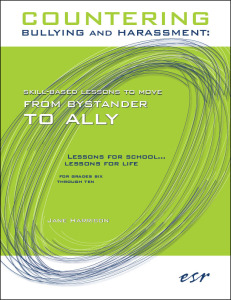 In our ongoing series in conjunction with National Bullying Prevention Month, we’ll consider recommendations that will help educators and school leaders to determine whether their classroom or school’s conditions will properly support a program that helps students identify, resist, and address various forms of bullying and harassment.
In our ongoing series in conjunction with National Bullying Prevention Month, we’ll consider recommendations that will help educators and school leaders to determine whether their classroom or school’s conditions will properly support a program that helps students identify, resist, and address various forms of bullying and harassment.
While these recommendations were developed for and adapted from Countering Bullying and Harassment: Skill-Based Lessons to Move from Bystander to Ally, Engaging Schools’ pro-social, anti-bullying curriculum for sixth through tenth grades, they offer useful considerations for educators to consider before implementing any meaningful effort to counter bullying and harassment. We hope you read on with this in mind: a curriculum or program aimed at forestalling bullying and harassment works best when it’s implemented in a school that’s already paying meaningful attention to creating a positive, supportive, and caring climate.
Is your classroom ready for an effective effort to counter bullying and harassment?
Effective and caring teachers not only promote academic success, they also build relationships, trust, and a sense of community in their classrooms. They emphasize a student-centered approach that follows students’ thinking and concerns in ways that build on students’ own knowledge and connect students’ own life experiences to what’s happening in the larger society.
Curricula such as Countering Bullying and Harassment work best in a safe and caring classroom. In a safe classroom, all students participate and all students feel that they belong. They know that their individual and cultural differences will be accepted and valued as much as the things that they share in common. Teachers show that everyone counts by balancing the emphasis on individual achievement with a commitment to the well-being of the whole classroom community.
In safe classrooms, students feel comfortable expressing their feelings and concerns. They know that they can make mistakes without being ridiculed, deal with their differences constructively, and disagree respectfully. The lessons in this curriculum work best in a classroom where each student can develop his or her own voice and where listening to peers matters as much as listening to teachers.
Before implementation, educators need to be tuned in not only to specific students but to also the group as a whole. What is occurring in the lives of the students in your classroom? Are students being bullied? Are there some who are targets and some who are perpetrators? Understanding the specific dynamics of your classroom will make a critical difference for effective facilitation.
Is your school ready for an effective effort to counter bullying and harassment?
These lessons should be one part of creating a positive school climate, the benefits of which have been identified through much research over the last thirty years. A positive on-campus environment reduces the frequency of many problematic behaviors at school, including bullying and harassment. Research has consistently identified an inverse relationship between specific components of positive school climate and bullying among students. A positive climate contributes to more consistent attendance, higher student achievement, and other desirable student outcomes.
Research also documents the importance of school-wide prevention efforts that provide positive behavior support, establish a common set of expectations for positive behavior across all school contexts, and involve all school staff in prevention activities.
Some schools may choose to focus specifically on an effort to counter bullying and harassment as part of a larger schoolwide discipline and student support initiative. Within such a schoolwide initiative, administrators, faculty, and staff members need to understand and manage student social dynamics, and to handle aggression with clear, consistent consequences.
Additionally, it is crucial that the school seek to create and promote an atmosphere where certain conduct is not tolerated—by students and staff alike. In schools with healthy climates, students know what is appropriate and what is not. Cultivating a positive school climate will not only promote student achievement and success, it will decrease bullying and harassment.
—
Please click here for more information about Engaging Schools’ Countering Bullying and Harassment: Skill-Based Lessons to Move from Bystander to Ally.
- Topics
- Advisory Plus (3)
- Annual Reports (1)
- Blog (66)
- Conferences (3)
- Countering Bullying and Harassment (4)
- Development (1)
- District Codes of Character, Conduct, and Support (2)
- Engaged Classrooms (11)
- Engaging Schools (12)
- Publications (8)
- Research (5)
- Schoolwide Discipline and Student Support (23)
- Social and emotional learning (10)
Twitter Feed





